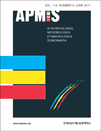Filiform serrated adenomatous polyposis arising in a diverted rectum of an inflammatory bowel disease patient
Part of this study has previously been presented at the annual meeting of Danish pathologists, APMIS 2009; vol 117, Suppl 126, 17.
Abstract
Klarskov L, Mogensen AM, Jespersen N, Ingeholm P, Holck S. Filiform serrated adenomatous polyposis arising in a diverted rectum of an inflammatory bowel disease patient. APMIS 2011; 119: 393–8.
A 54-year-old man, previously colectomized for inflammatory bowel disease, developed carcinoma in the inflamed rectum stump. The malignant growth was surrounded by a filiform polyposis, grossly considered as pseudopolyps. The histology disclosed, however, a morphology corresponding to the recently described filiform subset of serrated adenoma (FSA). The clustering of the FSA amounted to a filiform serrated adenomatous polyposis, a hitherto unreported observation. It is speculated that neoplastic transformation of pre-existing pseudopolyps and prolaps-related events lead to this peculiar morphology. Minor zones with a villous structure were admixed as were small areas of traditional serrated adenoma and patches of flat dysplasia. Although a combined gastric and intestinal (positivity for MUC5AC, MUC2, MUC6, CDX2) immunoprofile characterized the adenomatous component, a downregulation of the gastric mucin along with a loss of the serrated attribute accompanied the malignant transformation. An added dynamic shift during the adenoma carcinoma sequence included the acquisition of CK7 expression in the malignant portion. Gastric mucin may play a role in the initial step of the neoplastic evolution and CK7 may denote neoplastic progression. This case confirms the notion of a widely variegated morphology of precursor lesions of colorectal carcinoma arising in a chronically inflamed bowel as opposed to the generally more monotonous appearance of adenomas in a sporadic context.




